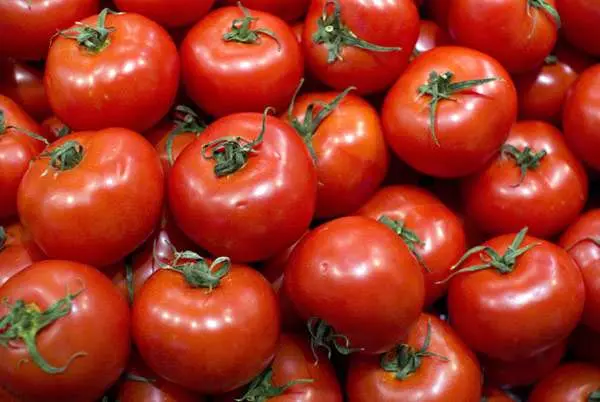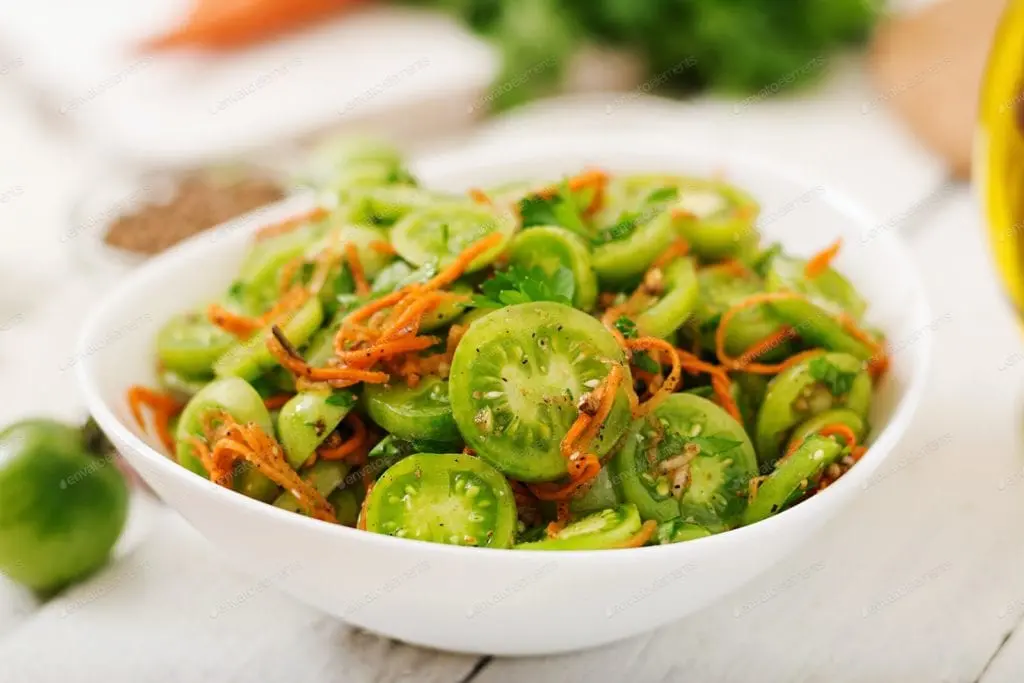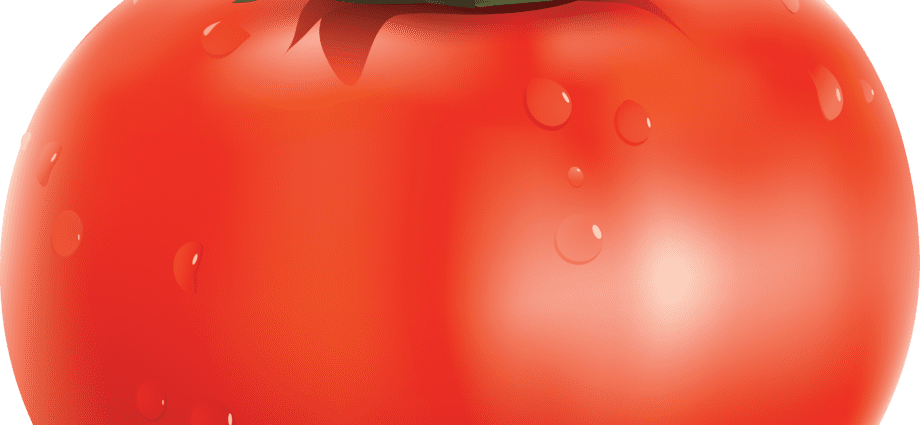Contents
Dietitians value tomatoes for their low calorie content and high amounts of lycopene, and chefs use them as a natural flavor enhancer. We will tell you how to take advantage of all the benefits of this either a fruit or a vegetable.
Tomato, or tomato (Solanum lycopersicum) is a plant from the Solanaceae family, native to South America. Although botanically a tomato is a fruit, it is usually eaten and cooked like a vegetable. Ripe tomatoes are red, but there are also pink, yellow, orange, green, purple and even black tomatoes. Different varieties of tomatoes differ in taste and composition of nutrients. Moreover, tomatoes are eaten both ripe and green.
Tomatoes: varieties
The most popular varieties of red tomatoes in our country are Casta (Supernova), Bagheera, Pietra Rossa, Rufus, Upgrade F1. They are quite juicy and meaty. One of the most popular tomatoes in our country are pink tomatoes from Kalinovka. They have a delicate yet expressive taste and are available all year round. The popular Black Prince variety is distinguished by its dark color and bright, rich taste. In late summer, the markets are dominated by cream tomatoes. Outwardly, Italian varieties are similar to them: San Marzano, with which Italian pizza is prepared, and Roma. In salads and stews in the form of confit, cherry tomatoes are used with a bright sweet taste. Connoisseurs hunt for Oxheart tomatoes during the season, and summer residents respect the De Barao tomato, which is red, black, pink and yellow.
Tomato: calorie content
In 100 g of tomato from 15 to 18 kcal. A tomato is 95% water. It is a low calorie and low carbohydrate food. The remaining 5% are mainly carbohydrates, primarily glucose and fructose, and insoluble fiber (about 1.5 g per medium tomato, mainly hemicellulose, cellulose and lignin).
Tomatoes: benefits

Tomatoes are rich in vitamin C, potassium, folate and vitamin K. However, tomatoes are most valuable because they are the main source of the powerful antioxidant lycopene, which reduces the risk of heart disease and cancer.
Nutrients in tomatoes
- Vitamin C. An important nutrient and antioxidant. One medium-sized tomato can provide about 28% of the Daily Value (RDI).
- Potassium. An essential mineral that is beneficial for blood pressure control and heart disease prevention.
- Vitamin K1, also known as phylloquinone. Vitamin K is important for blood clotting and bone health.
- Vitamin B9 (folate). It is important for normal tissue growth and cell functioning, which is especially important for pregnant women.
- Lycopene. The red pigment and antioxidant lycopene is the most abundant carotenoid in ripe tomatoes. The highest concentration is in the skin. More details on its effect are discussed below.
- Beta carotene. The antioxidant, which often gives food a yellow or orange hue, is converted into vitamin A in your body.
- Naringenin. This flavonoid, found in tomato skins, has been found to reduce inflammation and protect against various diseases in a mouse study.
- Chlorogenic acid. A powerful antioxidant compound that lowers blood pressure in hypertensive patients.
Lycopene

Generally, the redder the tomato, the more lycopene it contains. At the same time, it remains in cooked tomatoes, and due to the evaporation of moisture, the concentration of lycopene in them increases. Therefore, foods such as tomato sauce, ketchup, tomato juice, tomato paste are rich sources of lycopene. For example, 100 g of ketchup contains 10-14 mg of lycopene, while the same weight fresh tomato (100 g) contains only 1-8 mg. However, do not forget that the calorie content of ketchup is much higher. Our digestive tract is only able to process small amounts of lycopene – experts recommend 22 mg per day. To do this, it is enough to eat no more than two tablespoons of tomato puree.
Certain foods in your diet can have a profound effect on the absorption of lycopene. Thus, its absorption, together with the source of fat, increases fourfold.
A study in middle-aged men linked low blood levels of lycopene and beta-carotene with an increased risk of heart attacks and strokes. Thus, the benefit of lycopene is that it helps prevent heart disease. Eating tomatoes also lowers bad cholesterol, increases the elasticity of arterial walls, and has been shown to be effective in preventing prostate, lung, stomach and breast cancer.
Tomato and skin health
Tomato-based foods rich in lycopene and other plant compounds may protect against sunburn. According to a study, people who took 40 grams of tomato paste (equivalent to 16 mg of lycopene) with olive oil every day for 10 weeks experienced 40% fewer sunburn.
Tomatoes: harm

Tomatoes are generally well tolerated and tomato allergies are very rare. People who are allergic to grass pollen are more likely to be allergic to tomatoes in a similar way: itchy mouth, throat, or swelling of the mouth or throat. But the leaves of the tomato vine are toxic, they should not be eaten – this can cause severe irritation of the mouth and throat, vomiting, diarrhea, dizziness, headache, mild convulsions and even death.
Tomatoes: culinary ideas and recipes
Tomatoes are an important part of a healthy diet. These fruits are juicy and sweet, full of antioxidants, and can help prevent and fight disease. How do you eat them? Fortunately, this is one of the brightest products in cooking, one of the main sources of the fifth taste – umami. It is provided by the naturally occurring monosodium glutamate in tomatoes. Therefore, tomatoes and tomato paste can be called a natural flavor enhancer for the dishes where they are used.
The most popular are such recipes for cooking tomatoes as adjika from tomatoes, various preserves for the winter, pickled, pickled and salted tomatoes, homemade ketchup, tomato sauce, lecho. Moreover, tomatoes are used in cooking not only ripe, but also green. Green tomatoes are salted for the winter, they make jam, prepare a salad of green tomatoes, caviar.
Ideas for summer tomatoes

Eat them sliced and sprinkled with olive oil and lightly seasoned with sea salt.
Use in a salad seasoned with olive oil and seasoned with salt, pepper, dry oregano, or Provencal herbs. For nutritional value, add dried dark bread to the salad.
Make a tomato and mozzarella salad using tomatoes of all colors and sizes you will see on the market. This will add new flavors to it.
Make cold gazpacho soup. Experiment with colors, such as making a gazpacho with yellow tomatoes.
White tomato soup. Grate delicious ripe tomatoes and separate the liquid from the cake with cheesecloth. Add clear juice to cream and boil until creamy. Season to taste with salt and garlic. Serve with grilled shrimp or baby seafood, garnish with cherry tomatoes.
Korean Green Tomato Salad

Ingredients for 2 servings:
- 4 green tomatoes
- ½ onion
- 1-2 feathers of green onions or chives
- 1 clove garlic, press through
- 1 tbsp. l. ground sesame
- 2 tbsp. l. soy sauce
- 2 tbsp. l. white wine vinegar
- 1 tbsp. l. Sahara
- 1 tbsp. l. sesame oil
Cooking. Cut the tomatoes into thin slices. Chop the onion thinly and place in a bowl of cold water to remove the harsh taste. Chop green onions. Mix the last six ingredients from the list. Place the tomatoes on a dish, place the onions, which should be soaked with moisture, in the middle and sprinkle with chopped green onions. Pour sauce over – done.
Quick pickled tomatoes

- Ingredients:
- 2 kg small tomatoes such as cream
- 1 bunch of dill
- 10 cloves of garlic
- Marinade:
- 1 liter of water
- 2 tbsp salt with a small slide
- 3 tbsp sugar with a small slide
- 100 ml 9% vinegar
Dip the tomatoes for 30 seconds in boiling water, then in cold water, peel them. Fold in a pickling dish with chopped dill and garlic.
Prepare the marinade: mix salt, sugar and water, stirring occasionally, bring the mixture to a boil and turn off the heat. Pour vinegar into warm marinade. Cool the marinade completely. Pour the tomatoes with lukewarm marinade and cover. Marinating time 12 hours. Serve chilled and refrigerate.
Adjika from tomatoes

- 11/2 kg tomatoes
- 250 g bell pepper
- 5-6 chili peppers, pitted
- 21/2 heads of garlic
- 50 g horseradish root
- ½ tbsp salt
- 1 tbsp. spoonful of sugar
- 11/2 tsp vinegar
Cut the washed vegetables into slices, peel and chop the pepper. Peel the garlic. Pass all vegetables together with garlic and chili through a meat grinder. Add the grated horseradish and stir. Transfer the mixture to an enamel bowl and add all the spices and seasonings, stir and leave in the refrigerator overnight. In the morning, carefully drain all the liquid, and put the vegetable puree in jars. Adjika is ready. Keep refrigerated.










